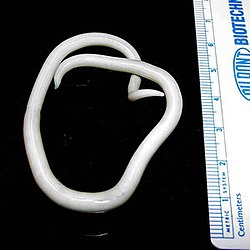Ascaris
| Ascaris | |
|---|---|
 |
|
| Adult female | |
| Scientific classification | |
| Kingdom: | Animalia |
| Phylum: | Nematoda |
| Class: | Chromadorea |
| Order: | Ascaridida |
| Family: | Ascarididae |
| Genus: |
Ascaris Linnaeus, 1758 |
| Species | |
Ascaris is a genus of parasitic nematode worms known as the "small intestinal roundworms", which is a type of helminth (parasitic worm). One species, Ascaris lumbricoides, affects humans and causes the disease ascariasis. Another species, Ascaris suum, typically infects pigs. Parascaris equorum, the equine roundworm, is also commonly called an "Ascarid".
Their eggs are deposited in feces and soil. Plants with the eggs on them infect any organism that consumes them.A. lumbricoides is the largest intestinal roundworm and is the most common helminth infection of humans worldwide. Infestation can cause morbidity by compromising nutritional status, affecting cognitive processes, inducing tissue reactions such as granuloma to larval stages, and by causing intestinal obstruction, which can be fatal.
The body is long, cylindrical, fusiform (pointed at both the ends), body wall is composed of cuticle, epidermis and musculature. Presence of a false body pseudocoelom not lined by epithelium. Digestive system is complete. Respiration by simple diffusion. Nervous system consists of a nerve ring and many longitudinal nerve cords. Only sexual reproduction. Sexes are separate with sexual dimorphism. Males are usually shorter than females.
As part of the parasite defense strategy, Ascaris roundworms secrete a series of inhibitors to target digestive and immune-related host proteases, which include pepsin, trypsin, chymotrypsin/elastase, cathepsins, and metallocarboxypeptidases (MCPs). Ascaris species inhibit MCPs by releasing an enzyme known as Ascaris carboxypeptidase inhibitor (ACI). This enzyme binds to the active site of MCP and blocks the cleavage of its own proteins by the host MCP.
...
Wikipedia
